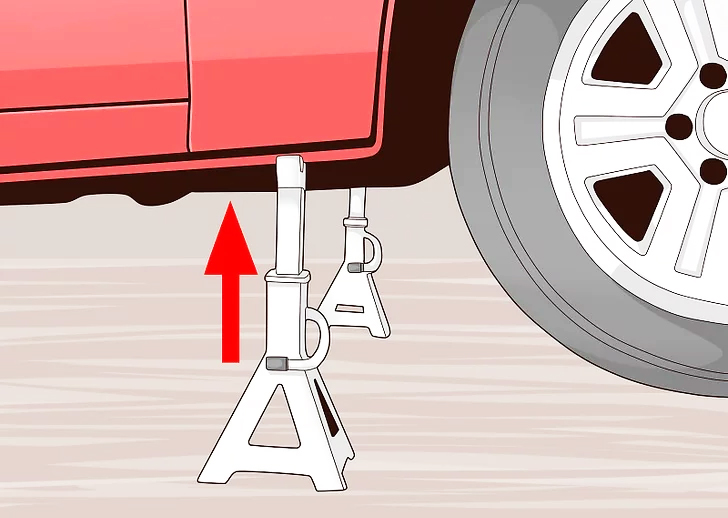There comes the time when you recognize something is wrong with your automobile it no longer drives or feels as it used to be. As you countersteer more and more, you can experience the car begin to drift in the right direction.
This is simply the key warning indication that your car suspension needs to be replaced. But how could you be certain that the suspension is the source of the problem?
Here Is How You Can Inspect Your Car’s Suspension Like A Pro;
1.Inspect All Strut Mounts Visually:
This is a simple process that does not need you to lift up the vehicle. Examine the shock towers on either side of your car, which normally protrude via the fender a little above each tyre and thus are held together by different nuts and bolts. Watch out for any symptoms of corrosion on fasteners, fasteners that are loose and damaged.
2. Check The Level Of Your Rear Tires:
Measure the amount of vacant space from the tip of the wheel towards the base of the mudguard on the driver’s side using a tape measure.
Repeat this process on both ends of passenger sides to see whether there is a height difference. If you detect a minor difference, that’s OK; the two ought to be nearly identical.
If one end is thinner compared to the other, it is most likely there is a problem. In case they are generally even, there may be a problem with the car suspensions that impacts both sides, that brings you to the next step ahead.

3. Time To Load The Vehicle:
You’ll require to get the jack out before you’re able to get beneath your automobile for a near look. Prior to actually attempting to elevate the automobile, check the owner’s manual for authorised jack positions. Attempting to jack up the automobile from the old position not only causes major harm to the car, but also putting you in a dangerous situation.
4. Check For Damage Signs:
If you’re having problems seeing below the automobile, a torch could come in handy. Examine the elastic bushings on every wheel one by one. This component aids in the separation of the suspension’s metal components. They are normally in black colour, but can turn grey over time due to any wear.
Any kind of cracks or rips in the bushings suggest that they need to be replaced. Whenever the rubber bushing wears out, it can no longer separate the metals, leading to a harsher, louder ride.
We recommend against driving your vehicle if a bushing is lacking or damaged since it limits the automobile’s capacity to endure shocks while travelling over bumps and therefore putting you as well as other drivers at peril.

5. Inspect Your Tie Rod:
This is a more complicated phase, but we’ll walk you through the same one by one. Identify the car power steering unit first, then start following the arms to the wheels. If you’re having difficulties finding it, consult the owner’s handbook as the placement changes by manufacturer and model.
Tie rod is an important component of car suspension because it connects the steering unit to the wheels. When the bushings wear out or are damaged, this can cause poor operation and dead areas when steering. All this makes driving exceedingly unsafe since it can impair your ability to operate your car.
Indications That Shows Your Car Require Suspension Replacement:
1. The Driving Is Bumpy
The first indicator that your car shocks are wearing out is the way you drive your car. You’ll begin to experience every minor road bump as if you’re going off-road, similar to a ‘bounce.’
2. Swerves Only In One Direction
If your car begins to drift towards one side when going straight, this is one major symptom that there’s a problem with the suspension. It is generally triggered by inconsistent wheel wear & pressure. Even if you’re not turning, you might realise the need to countersteer.
3. Trouble Driving
Is the steering wheel of your car becoming unresponsive? In case, if your car steering seems heavy, pulls to one direction, or doesn’t seem to respond when you spin, especially at low speeds, there’s a problem with your suspension. It might be caused by very low level steering fluid volume, else it might be much worse. We recommend consulting a professional if you are experiencing the same.
4. When Applying The Brakes, The Nose Dives
If your car suspensions are torn out, the whole front side of a car may ‘nose dive’ when you use the brakes forcefully. When this occurs, it is critical to schedule an inspection with your technician since it might impair your potential to halt the car swiftly in any alarming situation.
5. Uneven Wheel Tread
Whenever you find inconsistent wear in particular regions (bald patches), this indicates that the suspension isn’t keeping the car up uniformly, causing uneven levels of stress on the car wheels.
6. Shocks That Are Damaged And Greasy
If you see any fluid retention and the struts appear greasy, you most likely got a fluid leakage.
If your car steering fluid is leaking, your car suspension is just no longer functioning correctly and should be repaired. Driving with insufficient steering fluid may be quite risky.
Are you looking for an aftermarket suspension kit for your car? If so, check out our suspension selections for various SUVs and cars at The Auto Parts Shop.
